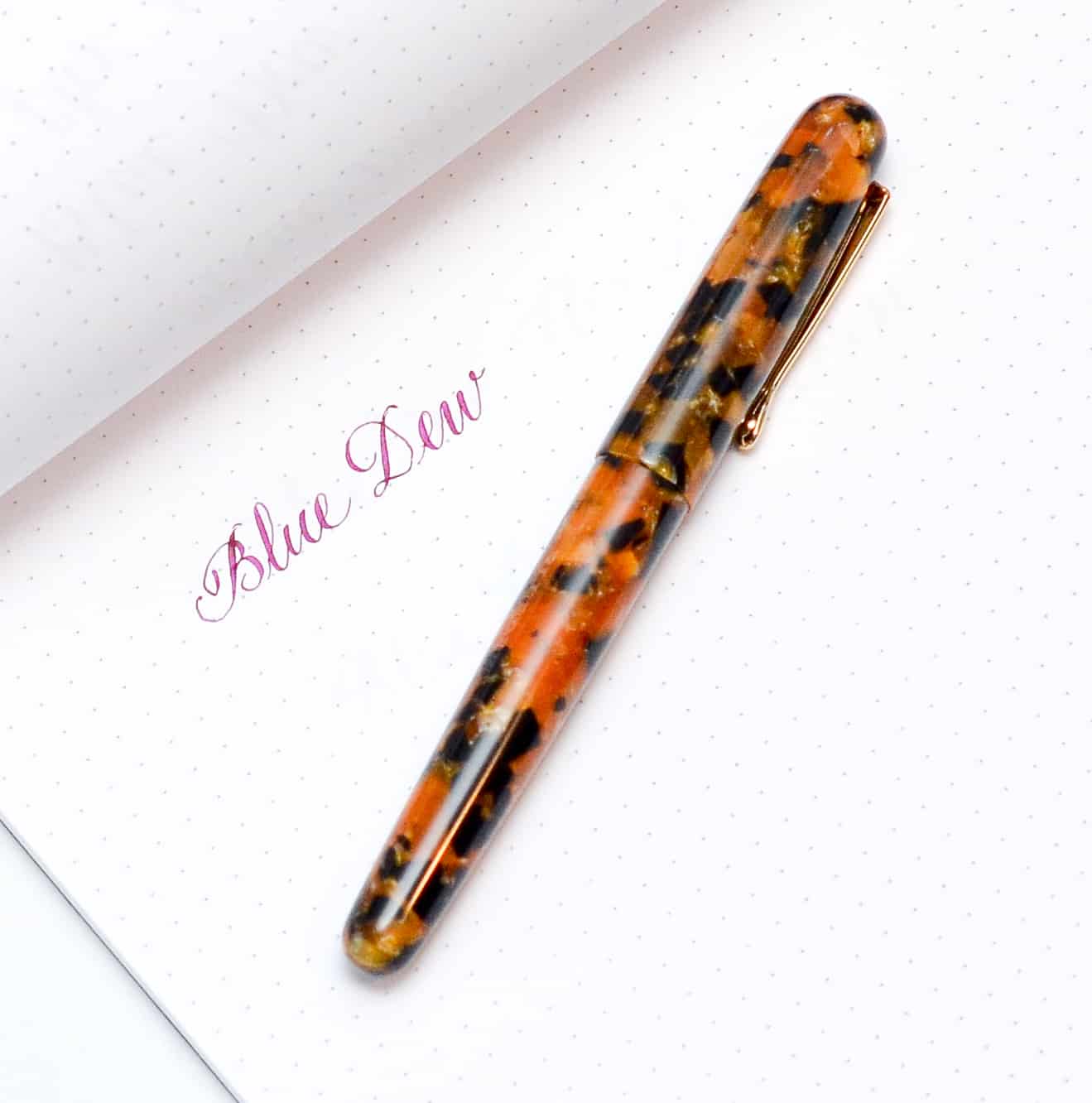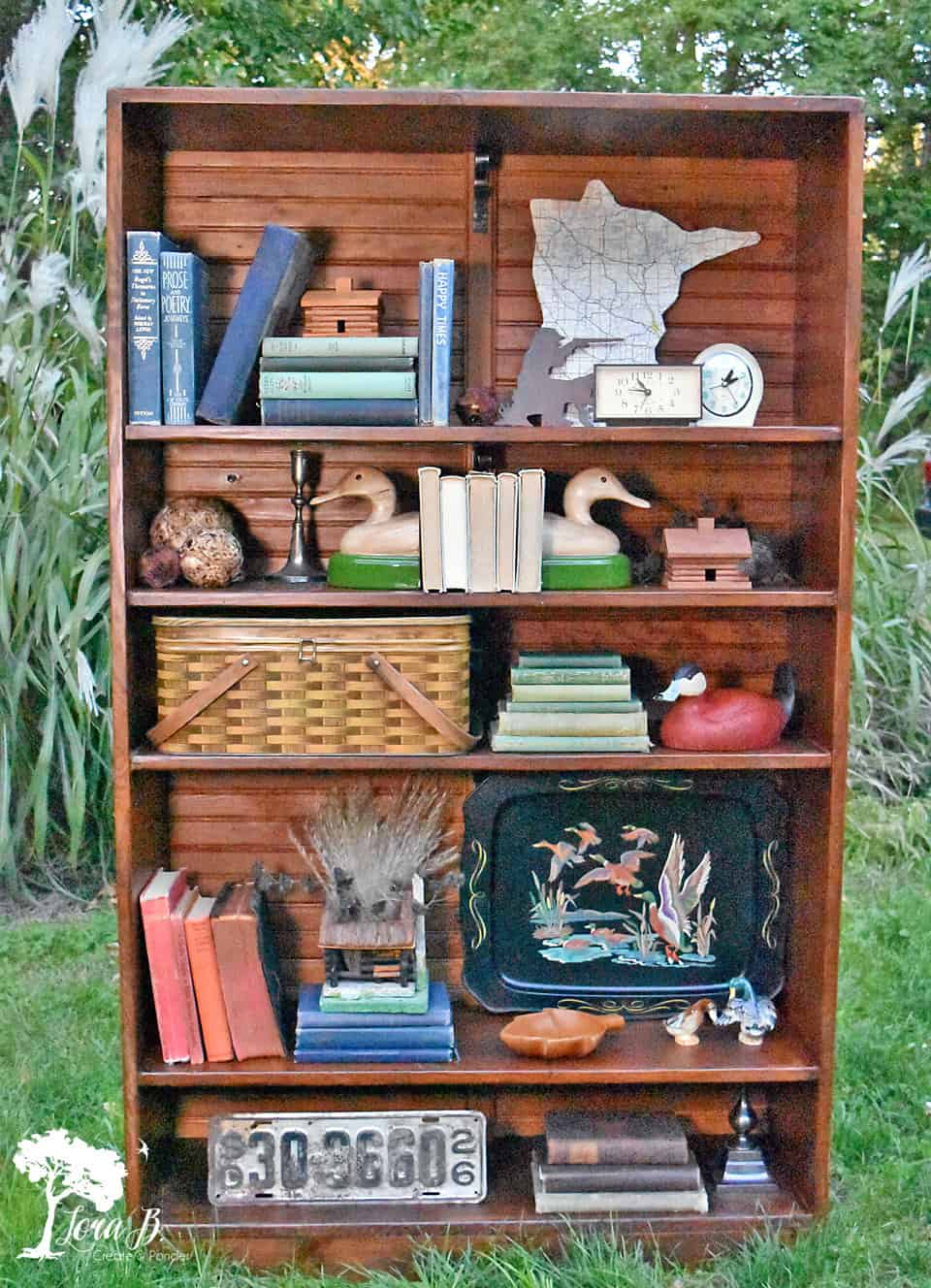BlueDew Flex Fountain Pen Review
Lately, I’ve become a student of the many different flex pen options out there. I have a few different ones in my collection, and I practice so much more calligraphy and handwriting, now that I’m not tied down to only using dip pens alone for nice line variation (thicks and thins.)
Today, I’m happy to share with you my review of my newest flex pen, the BlueDew flex fountain pen.
Read on for the pros and cons of this BlueDew flex fountain pen that was provided to me by BlueDew Pens, in return for my honest review.

This is the BlueDew flex fountain pen. The ink color (Pilot Iroshizuku Yama-Budo) might be an unconventional color choice for this pen, but I love it. I had it originally inked up with Aurora Black, and that was a nice, classic ink for this pen.
First Impressions
When I received my BlueDew flex pen, it arrived in a slim, classic protective case which is a really nice touch. (There are 2 versions of the case on the site, and mine was the newer one that they are sending now, without the braided texture.)
The pen includes a converter to fill with ink, and the FAQs at the website state that it can take cartridges, as well. It feels very comfortable and balanced to write with.
I received the Tortoise Shell, and it’s pretty and elegant, with lovely coloring and shimmery flecks. It also comes in several other colors.
It looks much prettier in person than in the photos, because the color of the pen and the shimmery material don’t photograph well (at least for me!) The pen is less “orangey” and more “ambery” than my photos depict it. Also, the nameplate on the case is reflective, which doesn’t show up well here.
The color of the pen is less intense than it shows up here.
The name of the company, BlueDew, is engraved on the side of the pen. It’s a nice detail, but not easy to see, because of the pen’s coloring and design. Maybe it would be seen more on the pen clip? Either way, it’s an extra touch. There is also engraving on the converter.
Let’s get right to the most unique aspect of this fountain pen – the nib.
The Nib
If you’ve ever done pointed pen calligraphy with a dip pen, you will have some idea of how the nib on the BlueDew flex fountain pen looks and feels. Dip pen nibs aren’t tipped, so they feel less smooth than a typical fountain pen nib. This lack of tipping is the reason that dip pens can achieve such extremely fine upstrokes, and this is true, too, of the BlueDew fountain pen’s propietary flex nib, which is also not tipped.
The nib is not really a dip pen nib, though; it is a proprietary nib, specially designed to be used with this fountain pen. So, unlike a dip pen nib, according to BlueDew, the nib isn’t prone to rust and will last longer.
If you’ve used a dip pen before, this lack of smoothness in the BlueDew flex fountain pen will feel normal to you, but if you have primarily been a fountain pen user, it will feel scratchy to you.
The nib has a very springy feel and can achieve nice flex. But, you absolutely shouldn’t apply too much pressure to this nib. It’s delicate and unable to take too much pressure, or it will spring. As the BlueDew website states, “Never try to explore the limits of the flex.”
The Flex
You really don’t have to apply much pressure to get flex with this pen. Very slight pressure gives quite a bit of line variation with it.
Writing with this pen feels amazingly like writing with a dip pen. The hairlines are the most fine I’ve ever gotten with a fountain pen. I absolutely love it for Copperplate and modern script calligraphy. (For the traditional calligraphy purists out there, this is a straight pen, not like an oblique dip pen, so the slant will be similar to that with a straight dip pen.)
I experience occasional railroading when writing with it, but I find this especially true when I’m putting too much pressure on the nib or when I write too quickly. I discovered, too, that the angle that I hold the pen makes a huge difference. When I hold the pen at less of a steep angle and don’t tilt the nib to the side, the pen’s performance is much better. (UPDATE: Over time, the pen gradually stopped railroading and doesn’t railroad at all, anymore. I’m wondering if the manufacturing oils on the nib were causing the problem, and possibly just wore off over time. I would recommend cleaning the nib before using, as the website recommends.)
The ink that you use will affect these characteristics, also. A smooth flowing ink will make a difference. The Pilot Iroshizuku Yama-budo ink (a gorgeous purple-pink color) behaves well in this pen. Aurora Black ink is another one I’ve tried, and it is wonderful in this pen, too.
The BlueDew flex pen is very well suited to someone who does calligraphy because, as I mentioned, this pen is more like a dip pen with the convenience of a fountain pen.
Final Thoughts
If your goal is to emulate a dip pen’s performance in a fountain pen, I think you would enjoy this pen, immensely. And, you won’t have to try to “frankenpen” your own, to get that lovely dip pen feel in a fountain pen! I’m delighted to have this pen in my collection, and I’ve been enjoying it daily.
UPDATE: Be aware, you cannot return the pen, once you have purchased it, which is a possible drawback. Jeffrey, at BlueDew does, though, do his best to resolve issues and gives excellent customer service.
Thanks again to BlueDew Pens providing the pen, in return for my honest review. All opinions are my own, and this post does not contain affiliate links.
Linking to:
Inspire Me Monday at Create with Joy










Oh my goodness a new (to me, at least) modern flex? Look at that line variation! I had never heard of this before, but I'm interested already. The rust-free part is attractive, of course, because modifying Jinhaos with Zebra G nibs always ends in sadness due to the rust.
Thanks for visiting! I tried to modify a Jinhao with a Zebra G a while back, and it ended in sadness for me, too. I never could get it to work. So I gave up!
Hi,
If you compare BlueDew pen to FPR himalaya ultra flex, which one has the the maximum line variation? Would you mind sharing some thoughts on their performance regarding railroading as well?
Thanks.
Hi April, In terms of line variation, the BlueDew is able to get slightly thinner upstrokes, almost like a dip pen (but only slightly thinner than the FPR Himalaya.) With the Himalaya, I'm comfortable using more pressure because it feels less delicate, so I'm able to get thicker downstrokes with it. Both of these are my absolute favorite flex pens so far. Both are amazing. When I first started using the BlueDew, it was railroading a lot, and I thought I might have sprung the nib, but after I changed the angle that I was holding the pen and started using less pressure, it was hardly railroading at all. The ink you use in the BlueDew is important, too. (It likes Iroshizuku a lot!) Regarding railroading, the Himalaya railroads less for me and is less picky about the ink I use. I truly love both of these pens so much. The BlueDew is like a dip pen that I need to be gentle with that rewards me with dip pen like lettering with amazingly fine hairlines, whereas my Himalaya is smoother, like a fountain pen and not as delicate and rewards me with amazing flex lettering as well. I hope this helps!
Howdy April! I have both the BlueDew and a FPR ultra flex nib on my Noodler’s Ahab. Both have their pros and cons for me…
The BlueDew
PROS:
* It’s a dream for calligraphy! Very thin lines on the upstrokes and beautiful line variation on the downstrokes.
* The pen body options are quite nice and they’ve even added more color options since I purchased in July.
* The shipping is actually pretty quick to the U.S. if memory serves me well, it was only about 2 weeks turnaround.
CONS:
* No returns.
* After purchasing from PenBBS, I was kind of bummed by how cheap the construction of this pen was for the dollar amount. With shipping, this puppy cost me $100 and it feels pretty cheap.
* The beauty of this pen is the nib. Though they sell the nib separately, the nib only fully fits their pen well capped. Unless you plan to remove the nib after every use, you will want to purchase the pen body as well.
* Mine leaks from the inside where the converter clips into the pen itself. I changed the converter twice and they all leak.
* I noted that the writing is beautiful, and it is…when it writes. I can get half a sheet of calligraphy practice in before it is done for the day. Once it starts making me prime for every stroke, I quit and grab my other calligraphy pens. This has ruined my writing experience more than it hasn’t, I hate to say.
* Def be open to working with the pen to find the “sweet spot.” One thing I never saw people mention when I was researching this is that you have a very strict sweet spot for success for this nib. The delicacy of the tiñes aside, that’s a give in with any calligraphy flex nib, this will not give much room for much deviation in angles when writing with it.
* It is very picky about the inks it will play kindly with. Pilot Iroshizuku inks seem to always be a win.
The FPR Ultra Flex Nib
PROS:
* It’s so affordable and they regularly run sales.
* You can get the nib with or without their pens. I use it on my cheap Noodler’s Ahab and it marries perfectly with a tiny heat set .
* I can honestly say that this thing is the perfect wet noodle writer. I’d liken it to a good modern nib that performs like a great vintage flex. Seriously. So serious that I’m still kicking myself for bothering with that BlueDew that I can’t return.
* They also sell a feed for it with a deeper channel should you need it. I bought one thinking that was a give in to use them together, but I didn’t need it after all. It’s plenty wet to use with the Noodler’s nib.
CONS:
* You might need to heat set it yourself to ensure success with it. Have no fear, that’s easy to do in 3 minutes. Just search ‘heat set nib Goulet Pens’ on YouTube and you won’t be sorry.
* It will eat ink like a mutha. It might even be too wet for some people.
I hope this was helpful in some way. I like the BlueDew, but not at that cost. I have to say that it’s my regretful pen purchase of the year. Ya win some and ya lose some.
Bee, those are really comprehensive pros and cons, and I agree with the vast majority of what you said! The BlueDew is so much like a dip pen, that it almost feels strange for me to compare it to a fountain pen. I think the main market for this pen is calligraphers. I’ve never had mine stop writing, but it definitely railroads more than my other flex pens. I bought a second BlueDew after I wrote the review, because I was able to get such nice lettering with the first one, and the newer one is way more finicky than the first. So I think the performance varies with each pen. I agree with you about the sweet spot; I mentioned in the review about having to write at a specific angle to get good results. I do find the BlueDew nib to be way more delicate than any of my other flex pens, which is my main issue with it. It’s really easy to spring. (Jeffrey, of BlueDew does warn about that at the website, though.) And, yes, the no return policy is definitely an issue! I will add that to my review. (To be fair, when I mentioned the issues with my second pen to him, Jeffrey did his best to resolve the issues, but returning the pen would have been better.)
P.S. Bee, we share the same love for the FPR Ultra Flex nib! I recently wrote a blog post about my pens with that nib. I hope you’ll give it a read. https://anartfulmom.com/2022/08/modern-flex-nib-fountain-pen-comparison-my-fpr-pens.html
Such a pretty pen! And a great review!
Alexandra
OnRockwoodLane.com
EyeLoveKnots.com
Thanks so much, Alexandra!
Thank you so much for sharing your post at our Senior Salon Pit Stop.
Pinned to Senior Salon Pit Stop InLinkz Linkup Shares board and tweeted @EsmeSalon #SeniorSalonPitStop
Thanks so much for sharing it, Esme – I appreciate it so much!
Thanks so much for stopping by!! I really appreciate it!! Looks like a great pen!
Hugs,
Debbie
Thanks for stopping by, Debbie!